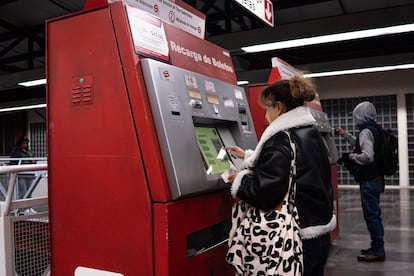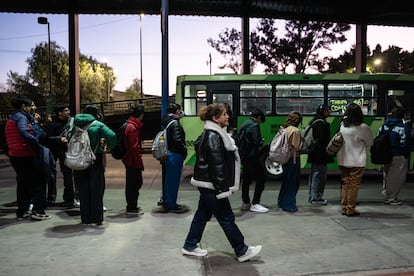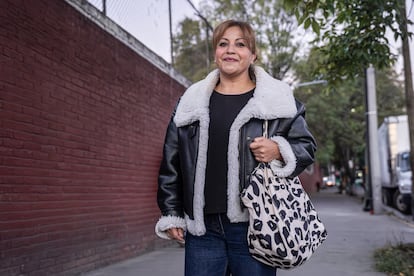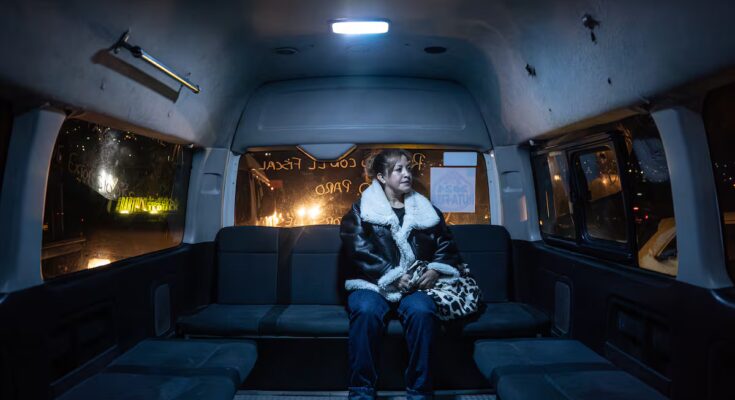At five in the morning, when it is still night in Coacalco, in the State of Mexico, about 40 kilometers from the center of the capital, Mireya Santos is already on the street. The 47-year-old woman walks two blocks, raises her hand and settles into the last available seat in one combined, What they call public transport vans. “I got lucky today, sometimes I wait up to 20 minutes and stand the whole way,” he says. Less fortunate passengers traveling standing perform all kinds of maneuvers during the half-hour journey to avoid falling due to the speed, potholes and braking of the journey, since there is nowhere to hold on. The silence to respect sleep is interrupted by the “good morning” of those who get on and off and by the request to pass the money to the driver. Mireya receives the change and realizes, “They already increased it.” He is referring to the increase in public transport fares in the State of Mexico and in the capital, which has especially affected the millions of people who cross the border between the two territories every day.
The 1.50 peso increase in ticket prices in the capital came into force on November 1st. Users began paying a minimum fare of 7.50 pesos for transportation in vans and minibuses and 8.50 for buses. Access to subsidized transportation also increased by nine pesos and the nightly fare – between 11 p.m. and 6:00 am – increased by 20%.
The agreement between Clara Brugada’s government and the hauliers came after days of tense negotiations and threats from the union to organize protests and blockades in the city to enforce their demands. Dealers sought to approve the increase approved a few weeks ago in the State of Mexico, which raised the base rate from 12 to 14 pesos.
For Mireya, who leaves the State of Mexico every day to go to the capital, the sum of the increases means about 42 pesos more per week. In her family economy – 17 thousand pesos a month, about 920 dollars, added between her salary, that of her husband and that of her eldest son – every peso counts. His family also depends on the public system and each spends about 58 pesos a day. “Sometimes we joke that with all the money we spend we could rent something closer to work, but rent is very expensive and it’s not easy to leave the house,” he says.
Mireya arrives at work just as the sun rises, just before seven in the morning, after taking three different means of transport: a combi, a suburban train and a bus to Vallejo, north of Mexico City. For her, the suburban offers the best service because “it is clean and well maintained”, even if the price is high: 25.50 pesos for three stations. “Trucks and vans are the worst,” he points out. “The drivers smoke, they drive badly and the devices are very neglected,” he says on board a truck with torn seats, an unstable handle and a Juan Gabriel song at full volume. In total, he spends four hours a day, six days a week, inside vehicles which he describes as “dangerous and exhausting”. Fear adds to the economic burden. In recent years he has suffered five attacks in vans.
20 kilometers away, in Tlalnepantla, Omar Serrano also gets up early. He is 31 years old and works in digital marketing in an office in Santa Fe, one of the most expensive and congested areas of the capital. The trip, four hours a day, costs 49 pesos. “The service is terrible. The units smell bad, have broken windows and the seats sink. I don’t expect a limousine, but you expect at least something decent,” he says wryly. “I don’t consider myself underpaid, but the money isn’t enough. If rents near work weren’t so expensive, I would move without hesitation,” he says. In their office many also experience eternal transfers and increasing expenses. “For those of us who work digitally, the home office It would be logical. There’s no point in going there just for tradition.”
Both Mireya and Omar agree that the increase will not improve service. “It’s to please the carriers, not to benefit the user,” he says. “I don’t blame the drivers,” he adds, “but rather the government, which should guarantee decent conditions.”
For their part, the increase is nowhere near enough for hauliers. Nicolás Rosales Pallares, president of the Mexican Association of Transport and Mobility (AMTM), points out that capital users – like Mireya – see the 1.50 peso increase as an expense and not an investment. “The fee does not affect the quality of the service,” he emphasizes. It is necessary, he says, that in addition to the tariff there are mechanisms that guarantee the modernization, training of operators and maintenance of the units. “But we won’t have it with a social tax rate.”
Víctor Arévalo, transport engineer at IPN, explains that the final cost of public transport is made up of two types of tariffs: the technical one and the social one. “The first It includes administrative, operational and management expenses, the acquisition of the fleet, the rental of spaces and elements that determine the real cost. At this real rate users would not be able to pay. In Mexico City, for example, it should be 25 pesos,” he explains.

The social tariff, explains Arévalo, is regulated by the Government and aims to ensure that the user does not pay such a high cost, but according to the specialist this ends up affecting the quality of the service. “If an adequate technical fee is not received, they must be relegated and perhaps sacrifice maintenance or operator training.”
In the State of Mexico, for example, since 2010 the real increase taking these considerations into account has been only 15 cents. Arévalo, who agrees that the most affected are always the users of the suburbs – due to a structural problem of centralization of services and work centers – explains: “Sometimes it is understood that the increase in tariffs is something that derives from pressure from the road haulage sector, from dealers, and not necessarily. The annual verification of tariffs is already established by law; in the case of Mexico City this review should be done during the first quarter of each year.”
Rosales Pallares, of the AMTM, ensures that the social tariff that allows accessibility and inclusion of users is harmful to the quality and modernization of public transport. “In 10 years it has been increased three times, which means that the law on mobility has not been respected. Furthermore, these increases have not considered the technical costs and the resources that are invested. This is up to the head of government to evaluate. Why don’t they do it? Well, because it has a high political cost. It is a reality,” he says.
Arévalo and Rosales Pallares agree that, in addition to a clear political will reflected in user subsidies – in the social tariff – a tariff policy is needed that is reviewed every year, taking inflation into account and that there are commitments from both sides, both the Government and the transporters, to modernize the fleets. According to Pallares, this will only be possible if the man-truck model, which works with private concessions or permits to private individuals, is changed., to a corporate one. However, he admits, the conditions to achieve this goal do not yet exist.

The vulnerability of students and the suburbs
A group of university students from the CDMX Better Mobility Collective protested this Thursday against the great price on public transport in the Capital and the Metropolitan Area, denouncing that the continuous increases especially affect those who have to take multiple means of transport every day to go to class. They marched from the Mother Monument to the Semovi with slogans such as “transport, first and foremost, the worker’s son” and delivered a petition calling for the repeal of the increase and the resignation of the Secretaries of Mobility of the State of Mexico and Mexico City.
Santiago Valencia Romero, a mobility specialist and graduate in Applied Geography from the National Autonomous University of Mexico, knows well the vulnerability of students from the suburbs. For his degree, he conducted a socioeconomic survey of 417 students in Ciudad Universitaria, in the south of the capital, to find out where they came from and how they got to school.
From his sample, distributed equally in each faculty, he found that almost 19% of students came from the State of Mexico and just over 81% from the capital. The vast majority of these two groups came from municipalities such as Gustavo A. Madero – about 40 kilometers away – or from Ecatepec or Chimalhuacán, in the State of Mexico, with journeys that took up to two hours on public transport.
“The people who have the least income and who invest the most in public transport are in the southeast sector, in Chalco and Ixtapaluca (both municipalities in the State of Mexico). What I think is, how is it possible that the highest fares (the Chalco trolleybus costs 20 pesos) are there, when it is the area where the students who spend the most on transport and who at the same time have the lowest family income live?” he asks. “With this double great price It affects those who live further away, in the State of Mexico and on the outskirts of the capital. The most affected are always those who live in the suburbs. It’s unfair,” he complains.

Omar shares Santiago’s reflection: “Public transport is an extension of the working day in old and overcrowded units.” And he argues: “It makes no sense to pay more to get the same thing.”



